Saturday, 16 July 2016, Le Bourget-du-Lac to Megève
Written 17 August 2016
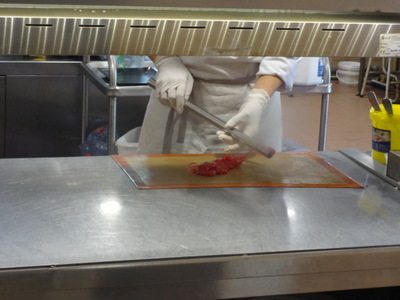
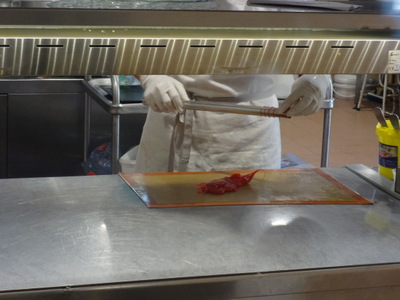 Saturday morning, pretty much right after breakfast, we packed up, wrestled our bags back down all those stairs, and were stopped in our tracks, or at least I was, by the view into the kitchens afforded by an open door. A young woman in chef's whites was making sugar coils with which to garnish the evening's desserts. (We never ate there, but the hotel's restaurant is apparently also well thought of, at least locally.)
Saturday morning, pretty much right after breakfast, we packed up, wrestled our bags back down all those stairs, and were stopped in our tracks, or at least I was, by the view into the kitchens afforded by an open door. A young woman in chef's whites was making sugar coils with which to garnish the evening's desserts. (We never ate there, but the hotel's restaurant is apparently also well thought of, at least locally.)
The red object, resting on the silpat mat, is a mass of sugar that she has cooked to the hard-crack stage, tinted red (and perhaps flavored), then cooled until it could be kneaded like silly putty. In the left-hand photo, she has pulled up a pinch of the mixture and stuck it to the side of a metal rod, which she is slowly twisting, pulling a uniform strand of the sugar up to form a coil around the rod. In the right-hand image, she is sliding the now-hardened coil (five or six turns) off the rod. I've been served those coils in French restaurants, and I knew theoretically how they were made, but it was cool to watch it done!
Then it was off to our next stop, Megève. We were, of course, going there for its restaurants, so we booked two nights—one for the highest-rated establishment of the trip, several kilometers from the town, and the other for its lesser, downtown, bistro-type branch.
Beyond eating, I wasn't sure what we would do there. How does one amuse oneself at a ski resort in July? The website of the Office de Tourisme mainly extolled the hiking possibilities. As it turned out, I need not have worried. Megève is a happening place!
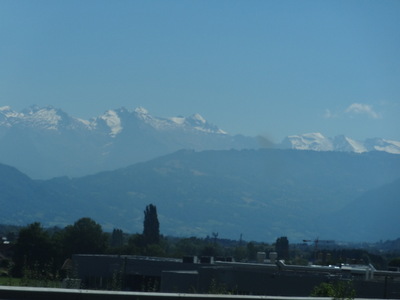
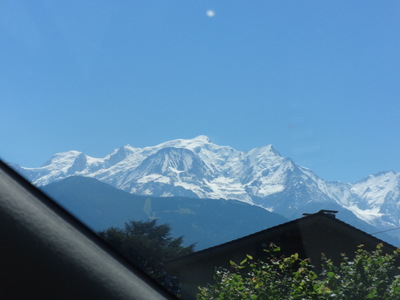 It started out as a sleepy little farming community that got a few skiers. Then, shortly after te turn of the 20th century, the Rothschilds started skiing there, because they were sick of St. Moritz. When Baroness Noémie de Rothschild built a house there and opened a luxury hotel in 1921. It turned into a resort frequented by the French nobility.
It started out as a sleepy little farming community that got a few skiers. Then, shortly after te turn of the 20th century, the Rothschilds started skiing there, because they were sick of St. Moritz. When Baroness Noémie de Rothschild built a house there and opened a luxury hotel in 1921. It turned into a resort frequented by the French nobility.
It's less than an hour from both Italy and Switzerland and within sight of Mont Blanc. I got these two photos of surrounding snow-capped peaks from the car as we drove there—one of them might conceivably be Mont Blanc, but I think mostly we were facing the wrong way. Near Etau, we passed a marker on route A410 that said we were at 803 m altitude, presumably the highest point on this segment of the trip (at least on the freeway; Megève is over 1000 m).
In the town, you run across the Rothschild name frequently, and one of the main streets is named for Edmond de Rothschild.
Our first decision, on leaving Le Bourget, was what route to take to Megève. We could go the shorter but slower route over the mountains on little bitty roads, or we could go the long way around via Aix-les-Bains and Annecy, which was freeway all the way until only about 10 km from the town. The only thing David hates worse than driving twisty little mountain roads is riding as a passenger over twisty little mountain roads, so we chose the freeway. Fortunately, the GPS concurred, so we didn't have to spend any time fighting with it. As a freeway, though, it could be a little odd. The ticket-based toll system worked very smoothly, but when we stopped for gas, we found that the entire rest area, which included a restaurant as well as a gas station, boasted only a single women's restroom stall!
The first clue, as we twisted our way up that last steep and windy nonfreeway section, was a series of plywood cutouts, life size but stylized, along the side of the road portraying bicyclists. The second was a series of bright yellow temporary signs along our route warning that the road we were driving on would be closed 21, 22, and 23 July—I hastily checked my calendar; whew!, we were scheduled to leave town on 18 July. The third clue was another yellow sign, this one stating the reason. The Tour de France would be passing over this very road!
By the time we reached town, we'd passed a rotary decorated with a tangle of real bicycles hung on a sort of metal tree and a topiary planting featuring a "Tour de France" sign and two bicyclists, one coasting over the finish line with his arms in the air, all made of shrubbery. (Two other rotaries were decorated with a life-sized figure in a chairlift and a life-sized cable car cabin.)
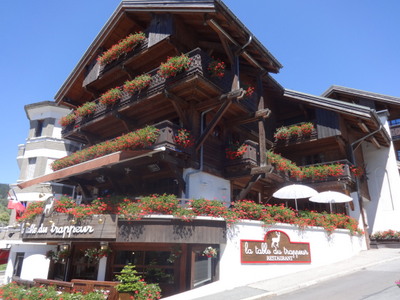
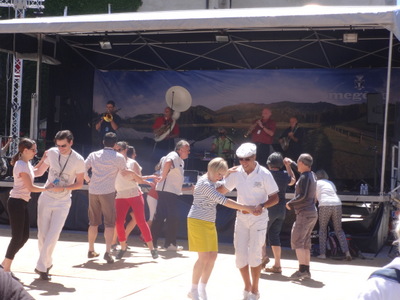 My call ahead to the hotel to ask about parking brought directions to the casino's parking garage, 100 m from the hotel, which I hoped would become comprehensible as we approached but didn't. Fortunately, we just kept heading for the middle of town (it's not very big) and fortuitously spotted the casino and its garage. All French parking garages are awful—tiny, cramped, and supported by way too many rough concrete or stone pillars. This one was worse than most; every space was separated from the next by a pillar. So we managed to scrape side of the rental car, trying to get it parked. Drat.
My call ahead to the hotel to ask about parking brought directions to the casino's parking garage, 100 m from the hotel, which I hoped would become comprehensible as we approached but didn't. Fortunately, we just kept heading for the middle of town (it's not very big) and fortuitously spotted the casino and its garage. All French parking garages are awful—tiny, cramped, and supported by way too many rough concrete or stone pillars. This one was worse than most; every space was separated from the next by a pillar. So we managed to scrape side of the rental car, trying to get it parked. Drat.
The photo at the left above is not of our hotel (it's a restaurant around the corner), but that's what our hotel looked like. We left our luggage there and set out to explore until our rooms were ready. The whole town is agressively quaint and alpine. As we strolled around, the first thing that caught our attention was music, specifically Dixieland! In the town square, this band was holding forth on a temporary stage while tourists and locals danced on a low wooden platform provided for the purpose. Turns out we had arrived on the second day of the three-day 23rd Magève Jazz Contest, and as we learned over the next couple of days, "jazz" for purposes of this contest was entirely confined to Dixieland, which I love (David, not so much). The finals would be held the next day in the town's civic auditorium and cost 25 euros, but until then, all over town, from temporary stages or just random street corners, Dixieland filled the air!
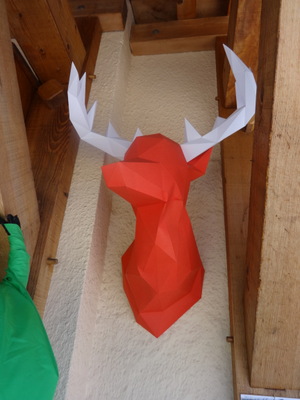
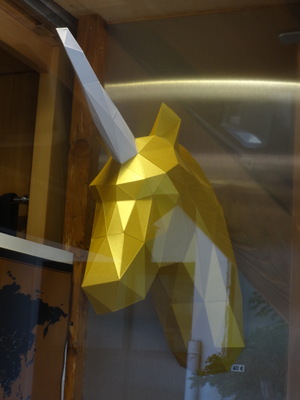 The town is filled with upscale shops, art galleries, and establishments offering lessons in all kinds of winter sports, as well as somthing called "summer luge"; sliding on little wheeled carts down sinuous tracks designed for the purpose. Some are apparently half tubes, others rails.
The town is filled with upscale shops, art galleries, and establishments offering lessons in all kinds of winter sports, as well as somthing called "summer luge"; sliding on little wheeled carts down sinuous tracks designed for the purpose. Some are apparently half tubes, others rails.
These two wonderful cardboard "trophy heads" were in the window of a sporting-goods store. Most portrayed real animals, but somehow a unicorn slipped in there.
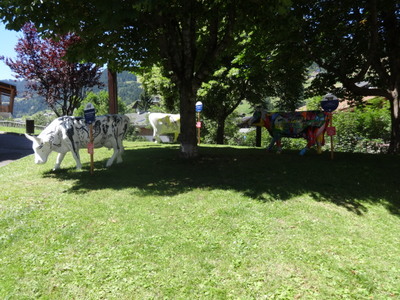
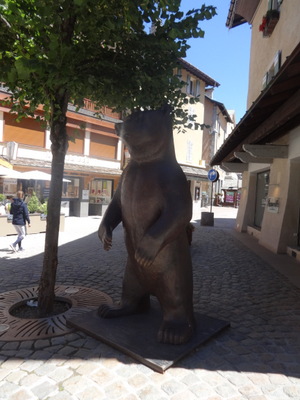 Other "wildlife" we encountered included these painted fiberglas cows (only part of a larger herd) and this large bear, presumably also fiberglas (outside an art gallery).
Other "wildlife" we encountered included these painted fiberglas cows (only part of a larger herd) and this large bear, presumably also fiberglas (outside an art gallery).
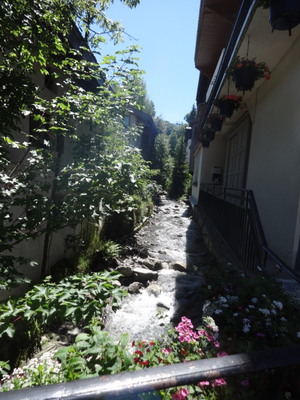
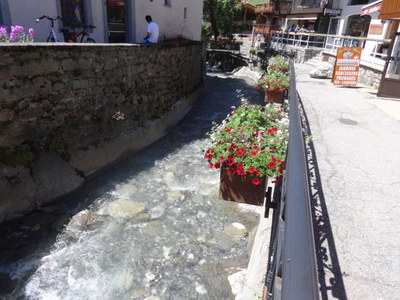 Running right through the middle of town was this lovely, and carefully landscaped, stream. The left-hand photo looks upstream, the right-hand one downstream.
Running right through the middle of town was this lovely, and carefully landscaped, stream. The left-hand photo looks upstream, the right-hand one downstream.
On the side of one large building is a huge vertical sundial, but I didn't manage to get a good photo of it.
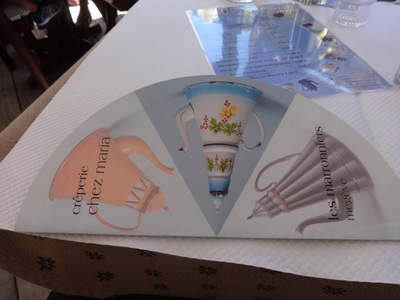
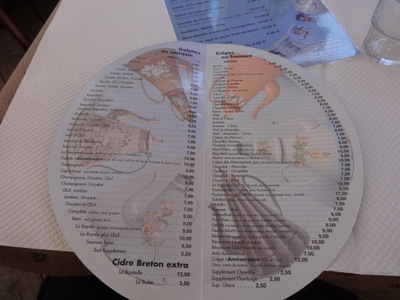 We found lunch at the Crêperie Chez Maria, which uses these interesting round menus. The
one at the left, shown closed, lists all the establishments teas and coffees.
We found lunch at the Crêperie Chez Maria, which uses these interesting round menus. The
one at the left, shown closed, lists all the establishments teas and coffees.
The open one at the right lists the crèpes, sweet to the right (from applesauce to rum to Nutella to salted caramel, almonds, honey, orange marmalade, or bananas; 2.5 euros extra to have it flamed) and savory to the left (and, at the bottom left, Breton hard cider). All those in the savory column are made with unsweetened buckwheat crêpes; those in the sweet column with ordinary wheat, which David can eat. We've pretty much given up begging kitchens to put a savory filling in a wheat crêpe for David's lunch, because the French invariably find the suggestion so shocking. The wheat batter has a little sugar in it, you see, and that couldn't possibly be paired with, e.g., ham and cheese, eggs, or salmon.
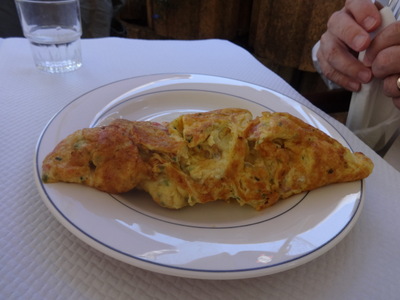
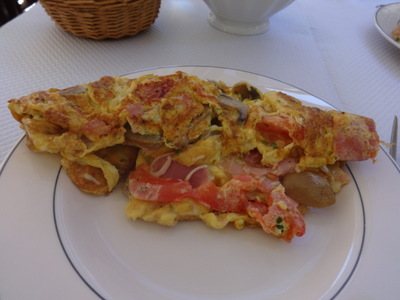 So we ordered omelets. David chose ham, cheese, and mushrooms, and I had the same with tomatoes added. I was flabbergasted when the waiter asked how we wanted the omelets cooked! No one, not even a French waiter, had ever asked us that before—you just ordered and took your chances. It was great to be able to specify that the eggs not be either running off the plate or petrified.
So we ordered omelets. David chose ham, cheese, and mushrooms, and I had the same with tomatoes added. I was flabbergasted when the waiter asked how we wanted the omelets cooked! No one, not even a French waiter, had ever asked us that before—you just ordered and took your chances. It was great to be able to specify that the eggs not be either running off the plate or petrified.
We ate outside, in a sort of sunken garden set into the hillside and surrounded by waist-high retaining walls built of decorative concrete blocks that served as planters as well as wall material, so flowers cascaded down the walls on all sides.
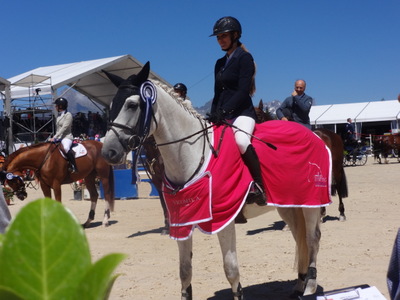
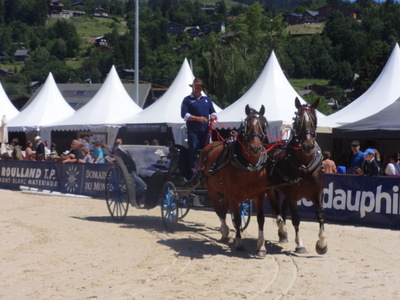 On our walk, we passed several posters advertising the 6th Annual Edmond de Rothschild International Equestrian Stadium Jumping event, looked at the dates, and realized it too was going on right then; we arrived on day 2 of 4.
On our walk, we passed several posters advertising the 6th Annual Edmond de Rothschild International Equestrian Stadium Jumping event, looked at the dates, and realized it too was going on right then; we arrived on day 2 of 4.
In the distance, back past our hotel, we realized we could see the warm-up ring and decided to walk down to watch the horses for a while. They were slenderer than those that show up at Red Hills for the three-day eventing, but were tall, elegant, and gorgeous; the riders were no slouches either! Hoping to see into the stadium itself, we wandered over toward the gate and were delighted to find that admission was free! An awards ceremony was in progress, so we stood at the rail to watch the officials present a prize to a young woman (a popular local girl, as far as we could gather), who had just won the "Vicomte A" trial. The event seemed to be divided into
"trials," one each morning and one each afternoon, which differed in configuration of the jumps, sponsorship, prize money (and form of prize—plaque, cup, ribbon, etc.). Vicomte A is an upscale clothing retailer; we later walked by their shop in Megève (others are in, e.g., Paris, London, Dubai). That awful pink horse blanket came with the prize and is in their trademark color.
The fancy horsedrawn wagon seemed to be mainly decorative, but it was used to bring the officials from the judging booth to the ground for the presentation. Another thing we saw a lot of in town was decorative horsedrawn wagons in which tourists could buy rides. We're told that in winter, they take the wheels off and add runners to turn them into sleighs.
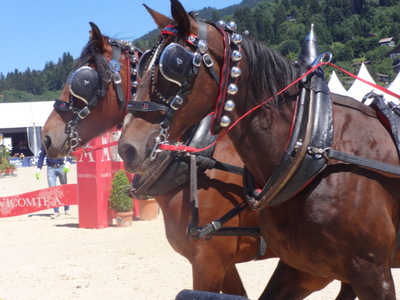
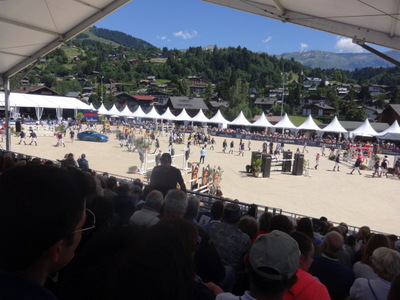 Here's a closer shot of the horses pulling the wagon. It's not telephotoed; that's how close we were. In the background, you can see the (violently pink) jump sponsored by Vicomte A.
Here's a closer shot of the horses pulling the wagon. It's not telephotoed; that's how close we were. In the background, you can see the (violently pink) jump sponsored by Vicomte A.
They were clearly setting up for the afternoon trial, so we went and got seats in the grandstand before it got crowded. (It never really did get crowded. We could have found seats anytime, but we got ideally placed ones.)
At a specified time before each trial, and for a specified length of time, the riders are let into the arena area to walk the course. Most of them pace off the distances between jumps, so they tend to end of up in long files, following each other around, taking giant steps from fence to fence.
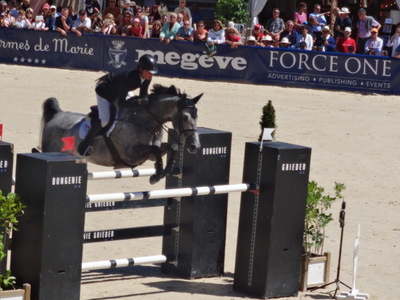
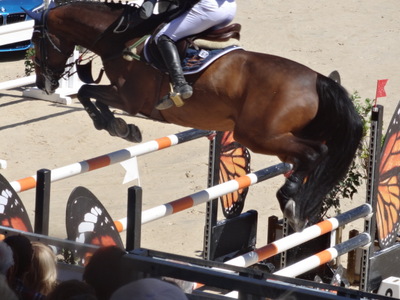 By assiduous application of my telephoto, I was able to get some pretty good shots, although, as you can see in the right-hand photo, in my eagerness to get the whole horse and the jump into the frame, I tended to cut off the rider's head.
By assiduous application of my telephoto, I was able to get some pretty good shots, although, as you can see in the right-hand photo, in my eagerness to get the whole horse and the jump into the frame, I tended to cut off the rider's head.
The course consisted of 13 jumps, arranged in a complicated sort of twisted figure eight. While each horse completed the course, the next horse in line was allowed into the arena, and as long as it stayed out of the other horse's way, had a chance to look over the jumps. Some riders took their horses to particular jumps and let them stick their heads right in there to see what was what. Others just trotted up and down.
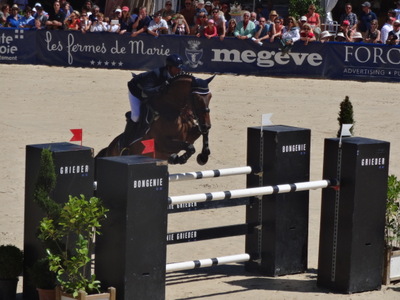
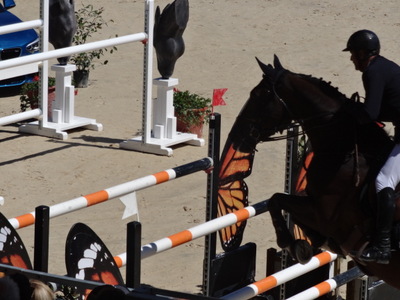
When a horn sounded, a clock started counting down the 30 seconds allowed for the rider to get the horse across the starting line. When the horse crossed the electric-eye beam at the starting line, the clock instantly started counting up in seconds, continuing until the horse crossed the electronic finish line.
A typical to get around the course was ca. 80 seconds, but a second clock registered penalties (also in seconds, I think): 4 for knocking a bar off a jump, other amounts for, e.g., balking at a jump. As you can see from the photos, those jumps were seriously high, wide, and difficult; out of 40 or 50 rounds we watched over two days, we saw only a half dozen or so clean rounds.
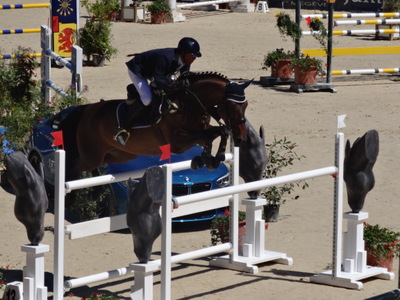
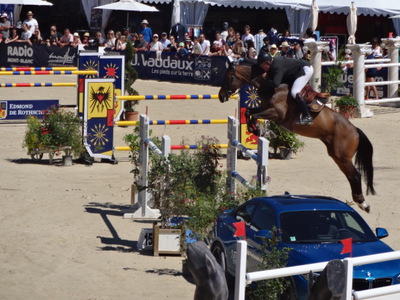 In a couple of the shots, you can see a bright blue Mercedes parked between two of the jumps. I'm note sure whether it was a prize or just advertising for one of the sponsors. The horses all managed not to kick it, but it got covered with sand in the course of the afternoon.
In a couple of the shots, you can see a bright blue Mercedes parked between two of the jumps. I'm note sure whether it was a prize or just advertising for one of the sponsors. The horses all managed not to kick it, but it got covered with sand in the course of the afternoon.
The reason the riders all pace off the distances so carefully is that they are apparently constantly signalling to the horse (who, remember, has not had a chance to run the course before) what foot to be leading with, how fast to go (i.e., how long a stride to use), and when to take off for each jump. Most of the horses were well behaved and instantly obedient, but we saw a few become obstreperous. One bucked and kicked, then acted as though he planned to jump the barrier into the restaurant tent. His rider whacked him smartly with her crop (you could hear it all the way up to where we were sitting), dragged his head around, and got him to complete the course without further incident. Another horse stopped between jumps and hopped up and down on his front feet. I interpreted that as a dialog with the rider—"I said lead with your left foot." "But I want to lead with my right." "Lead with your left!" "No, I'll lead with my right." "Left!!" The rider finally won, and the horse finished the course, but his time was not stellar. A couple of horses simply balked at jumps; the riders circled them back (at cost of many seconds) and had a second try. And a couple of riders, after maybe a balk and three fallen bars, simply looked at the scoreboard and abandoned the round.
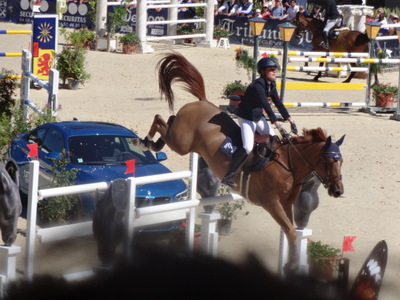
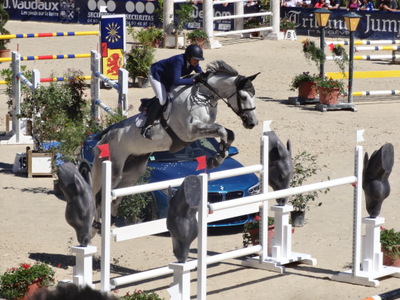 A particular difficulty seemed to be getting the horse's stride right for clearing double jumps, where the horse goes over one jump, then each foot only touches the ground once or twice before he has to go over another. Because the horses were all different sizes, riders and trainers seemed to be holding long discussions on the topic during the walk-around. You could see during the rounds that horses sometimes hesitated before launching, when the rider tried to adjust for the right approach.
A particular difficulty seemed to be getting the horse's stride right for clearing double jumps, where the horse goes over one jump, then each foot only touches the ground once or twice before he has to go over another. Because the horses were all different sizes, riders and trainers seemed to be holding long discussions on the topic during the walk-around. You could see during the rounds that horses sometimes hesitated before launching, when the rider tried to adjust for the right approach.
At one point in the trial, though, a chestnut horse, definitely on the small side and ridden by a diminutive girl, came out and just waltzed around the course, clearing every jump smoothly in stride, never touching a bar, fitting his stride perfectly inside the double jumps, incurring no penalties, and finishing in an astonishing 73 seconds. The crowd went wild! We didn't stay for the awards after that one, but that had to be the winning ride.
I'm almost surprised we didn't run into Princess Anne or Angelina Jolie.
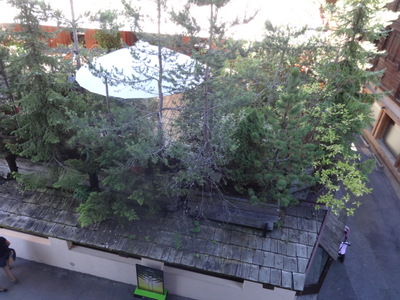
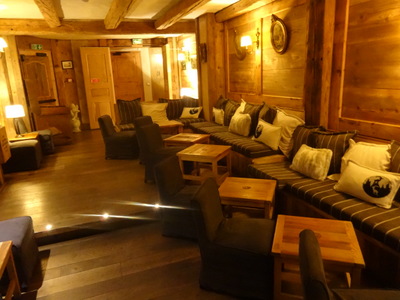 By the time we hiked back up the hill to our hotel our rooms were long since ready. Here, at the left, is the view from my balcony down onto a wooded roof garden, with picnic table and café umbrella. I never did learn whether it was part of a private residence or attached to a hotel. I left the window open to listen to the Dixieland wafting up from the street.
By the time we hiked back up the hill to our hotel our rooms were long since ready. Here, at the left, is the view from my balcony down onto a wooded roof garden, with picnic table and café umbrella. I never did learn whether it was part of a private residence or attached to a hotel. I left the window open to listen to the Dixieland wafting up from the street.
In the lobby (or rather, one of the lobbies), David came across an amazing antique wooden pinball machine. It didn't quite work, but we enjoyed figuring out how it was supposed to function.
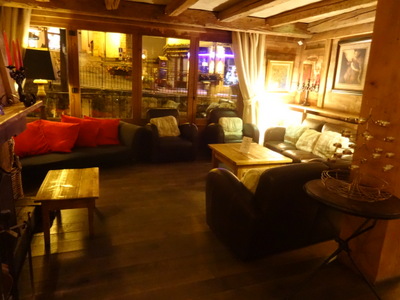
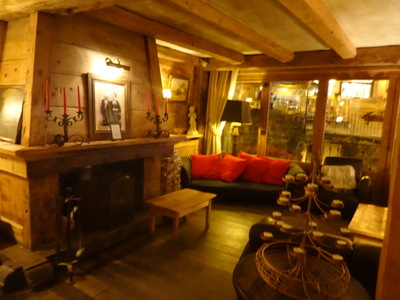 The lobby areas were just as quaint (though luxurious and comfortable) as the exterior. Just the place to spend some time before the fire with a peppermint-schnaps-spiked hot chocolate after a long day on the ski slopes.
The lobby areas were just as quaint (though luxurious and comfortable) as the exterior. Just the place to spend some time before the fire with a peppermint-schnaps-spiked hot chocolate after a long day on the ski slopes.
The little stream pictured above ran by, just below these windows, between the hotel and the side street.
Dinner was at Flocons Village, the bistro-style downtown branch of Flocons de Sel ("Flakes of Salt"; "flocons de neige" means "snowflakes"), a two-minute walk from our hotel.
The amuse-bouche looked like fried mozzarella sticks but turned out to be long thin croquets of mashed potato with smoked fish. Excellent.
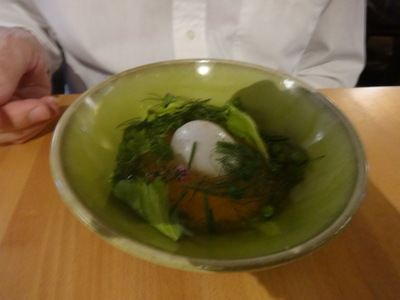
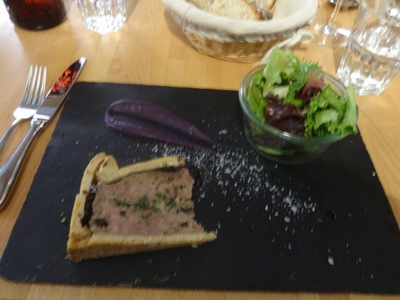 David's first course was an egg in aspic. The aspic contained shredded carrot and herbs, and the egg was embedded in the top to half its depth, then garnished with celery leaves and lots of chives and dill. He pronounced it delicious.
David's first course was an egg in aspic. The aspic contained shredded carrot and herbs, and the egg was embedded in the top to half its depth, then garnished with celery leaves and lots of chives and dill. He pronounced it delicious.
I chose house-made pâté en croute with condiments. The condiments turned out to be a beet purée, a scattering of coarse salt, a small salad, and a spinkling of fresh herbs. But condiments were not needed; the pâté itself was outstanding, and its crust and the thin layer of aspic between the two were equally delicious. Sure wish I new how to make a pâté come out like that!
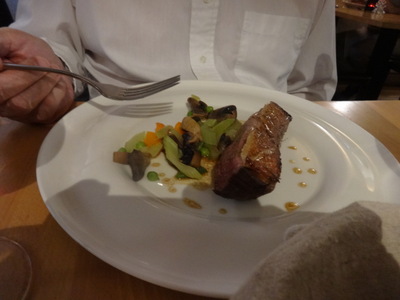
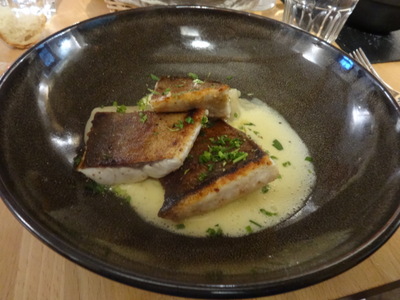 David main course was a thick slice from a rare, panroasted breat of duck.
David main course was a thick slice from a rare, panroasted breat of duck.
I had "féra du lac croustillant"—crispy féra from the lake. Féra (Coregonus fera ) is an extremely close relative of the lavaret. It comes from Lake Geneva, whereas lavaret comes from the Lac du Bourget. Both are scrumptious.
With the main courses, they brought little cast-iron casseroles of the vegetable medley that came with the duck and the lemon risotto that accompanied the duck, plentiful enough for both of us to eat both.
The predessert was apricot soup with a sugar crust on top and geranium mousse.
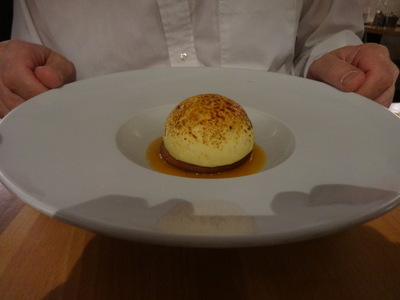
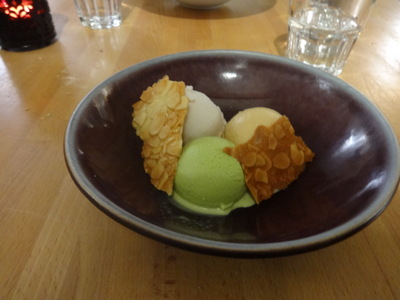 For dessert, David chose "chibouste" of apricot. Chibouste is a kind of mixture of meringue and custard, and this one came in the shape of a dome, with a crispy crème-brulée topping and a filling of stewed apricots.
For dessert, David chose "chibouste" of apricot. Chibouste is a kind of mixture of meringue and custard, and this one came in the shape of a dome, with a crispy crème-brulée topping and a filling of stewed apricots.
I chose three flavors of ice cream—coffee, pistachio, and coconut, I think—which came garnished with pieces of almond tuile cookie.
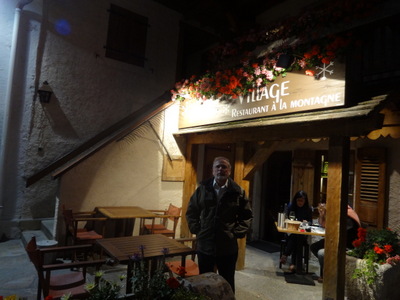 Here, David poses outside the restaurant. Notice that he's actually wearing a jacket. The heat wave in France broke just as we climbed up into the mountains, with the result that it was pretty chilly in the evenings. Of course, the heat wave set back in promptly when we returned to the relative lowlands . . .
Here, David poses outside the restaurant. Notice that he's actually wearing a jacket. The heat wave in France broke just as we climbed up into the mountains, with the result that it was pretty chilly in the evenings. Of course, the heat wave set back in promptly when we returned to the relative lowlands . . .
Previous entry
List of Entries
Next entry

 Saturday morning, pretty much right after breakfast, we packed up, wrestled our bags back down all those stairs, and were stopped in our tracks, or at least I was, by the view into the kitchens afforded by an open door. A young woman in chef's whites was making sugar coils with which to garnish the evening's desserts. (We never ate there, but the hotel's restaurant is apparently also well thought of, at least locally.)
Saturday morning, pretty much right after breakfast, we packed up, wrestled our bags back down all those stairs, and were stopped in our tracks, or at least I was, by the view into the kitchens afforded by an open door. A young woman in chef's whites was making sugar coils with which to garnish the evening's desserts. (We never ate there, but the hotel's restaurant is apparently also well thought of, at least locally.)
 It started out as a sleepy little farming community that got a few skiers. Then, shortly after te turn of the 20th century, the Rothschilds started skiing there, because they were sick of St. Moritz. When Baroness Noémie de Rothschild built a house there and opened a luxury hotel in 1921. It turned into a resort frequented by the French nobility.
It started out as a sleepy little farming community that got a few skiers. Then, shortly after te turn of the 20th century, the Rothschilds started skiing there, because they were sick of St. Moritz. When Baroness Noémie de Rothschild built a house there and opened a luxury hotel in 1921. It turned into a resort frequented by the French nobility. 
 My call ahead to the hotel to ask about parking brought directions to the casino's parking garage, 100 m from the hotel, which I hoped would become comprehensible as we approached but didn't. Fortunately, we just kept heading for the middle of town (it's not very big) and fortuitously spotted the casino and its garage. All French parking garages are awful—tiny, cramped, and supported by way too many rough concrete or stone pillars. This one was worse than most; every space was separated from the next by a pillar. So we managed to scrape side of the rental car, trying to get it parked. Drat.
My call ahead to the hotel to ask about parking brought directions to the casino's parking garage, 100 m from the hotel, which I hoped would become comprehensible as we approached but didn't. Fortunately, we just kept heading for the middle of town (it's not very big) and fortuitously spotted the casino and its garage. All French parking garages are awful—tiny, cramped, and supported by way too many rough concrete or stone pillars. This one was worse than most; every space was separated from the next by a pillar. So we managed to scrape side of the rental car, trying to get it parked. Drat.
 The town is filled with upscale shops, art galleries, and establishments offering lessons in all kinds of winter sports, as well as somthing called "summer luge"; sliding on little wheeled carts down sinuous tracks designed for the purpose. Some are apparently half tubes, others rails.
The town is filled with upscale shops, art galleries, and establishments offering lessons in all kinds of winter sports, as well as somthing called "summer luge"; sliding on little wheeled carts down sinuous tracks designed for the purpose. Some are apparently half tubes, others rails.
 Other "wildlife" we encountered included these painted fiberglas cows (only part of a larger herd) and this large bear, presumably also fiberglas (outside an art gallery).
Other "wildlife" we encountered included these painted fiberglas cows (only part of a larger herd) and this large bear, presumably also fiberglas (outside an art gallery). 
 Running right through the middle of town was this lovely, and carefully landscaped, stream. The left-hand photo looks upstream, the right-hand one downstream.
Running right through the middle of town was this lovely, and carefully landscaped, stream. The left-hand photo looks upstream, the right-hand one downstream.
 We found lunch at the Crêperie Chez Maria, which uses these interesting round menus. The
one at the left, shown closed, lists all the establishments teas and coffees.
We found lunch at the Crêperie Chez Maria, which uses these interesting round menus. The
one at the left, shown closed, lists all the establishments teas and coffees.
 So we ordered omelets. David chose ham, cheese, and mushrooms, and I had the same with tomatoes added. I was flabbergasted when the waiter asked how we wanted the omelets cooked! No one, not even a French waiter, had ever asked us that before—you just ordered and took your chances. It was great to be able to specify that the eggs not be either running off the plate or petrified.
So we ordered omelets. David chose ham, cheese, and mushrooms, and I had the same with tomatoes added. I was flabbergasted when the waiter asked how we wanted the omelets cooked! No one, not even a French waiter, had ever asked us that before—you just ordered and took your chances. It was great to be able to specify that the eggs not be either running off the plate or petrified.
 On our walk, we passed several posters advertising the 6th Annual Edmond de Rothschild International Equestrian Stadium Jumping event, looked at the dates, and realized it too was going on right then; we arrived on day 2 of 4.
On our walk, we passed several posters advertising the 6th Annual Edmond de Rothschild International Equestrian Stadium Jumping event, looked at the dates, and realized it too was going on right then; we arrived on day 2 of 4.
 Here's a closer shot of the horses pulling the wagon. It's not telephotoed; that's how close we were. In the background, you can see the (violently pink) jump sponsored by Vicomte A.
Here's a closer shot of the horses pulling the wagon. It's not telephotoed; that's how close we were. In the background, you can see the (violently pink) jump sponsored by Vicomte A.
 By assiduous application of my telephoto, I was able to get some pretty good shots, although, as you can see in the right-hand photo, in my eagerness to get the whole horse and the jump into the frame, I tended to cut off the rider's head.
By assiduous application of my telephoto, I was able to get some pretty good shots, although, as you can see in the right-hand photo, in my eagerness to get the whole horse and the jump into the frame, I tended to cut off the rider's head.


 In a couple of the shots, you can see a bright blue Mercedes parked between two of the jumps. I'm note sure whether it was a prize or just advertising for one of the sponsors. The horses all managed not to kick it, but it got covered with sand in the course of the afternoon.
In a couple of the shots, you can see a bright blue Mercedes parked between two of the jumps. I'm note sure whether it was a prize or just advertising for one of the sponsors. The horses all managed not to kick it, but it got covered with sand in the course of the afternoon.

 A particular difficulty seemed to be getting the horse's stride right for clearing double jumps, where the horse goes over one jump, then each foot only touches the ground once or twice before he has to go over another. Because the horses were all different sizes, riders and trainers seemed to be holding long discussions on the topic during the walk-around. You could see during the rounds that horses sometimes hesitated before launching, when the rider tried to adjust for the right approach.
A particular difficulty seemed to be getting the horse's stride right for clearing double jumps, where the horse goes over one jump, then each foot only touches the ground once or twice before he has to go over another. Because the horses were all different sizes, riders and trainers seemed to be holding long discussions on the topic during the walk-around. You could see during the rounds that horses sometimes hesitated before launching, when the rider tried to adjust for the right approach.
 By the time we hiked back up the hill to our hotel our rooms were long since ready. Here, at the left, is the view from my balcony down onto a wooded roof garden, with picnic table and café umbrella. I never did learn whether it was part of a private residence or attached to a hotel. I left the window open to listen to the Dixieland wafting up from the street.
By the time we hiked back up the hill to our hotel our rooms were long since ready. Here, at the left, is the view from my balcony down onto a wooded roof garden, with picnic table and café umbrella. I never did learn whether it was part of a private residence or attached to a hotel. I left the window open to listen to the Dixieland wafting up from the street.
 The lobby areas were just as quaint (though luxurious and comfortable) as the exterior. Just the place to spend some time before the fire with a peppermint-schnaps-spiked hot chocolate after a long day on the ski slopes.
The lobby areas were just as quaint (though luxurious and comfortable) as the exterior. Just the place to spend some time before the fire with a peppermint-schnaps-spiked hot chocolate after a long day on the ski slopes.
 David's first course was an egg in aspic. The aspic contained shredded carrot and herbs, and the egg was embedded in the top to half its depth, then garnished with celery leaves and lots of chives and dill. He pronounced it delicious.
David's first course was an egg in aspic. The aspic contained shredded carrot and herbs, and the egg was embedded in the top to half its depth, then garnished with celery leaves and lots of chives and dill. He pronounced it delicious.
 David main course was a thick slice from a rare, panroasted breat of duck.
David main course was a thick slice from a rare, panroasted breat of duck.
 For dessert, David chose "chibouste" of apricot. Chibouste is a kind of mixture of meringue and custard, and this one came in the shape of a dome, with a crispy crème-brulée topping and a filling of stewed apricots.
For dessert, David chose "chibouste" of apricot. Chibouste is a kind of mixture of meringue and custard, and this one came in the shape of a dome, with a crispy crème-brulée topping and a filling of stewed apricots. Here, David poses outside the restaurant. Notice that he's actually wearing a jacket. The heat wave in France broke just as we climbed up into the mountains, with the result that it was pretty chilly in the evenings. Of course, the heat wave set back in promptly when we returned to the relative lowlands . . .
Here, David poses outside the restaurant. Notice that he's actually wearing a jacket. The heat wave in France broke just as we climbed up into the mountains, with the result that it was pretty chilly in the evenings. Of course, the heat wave set back in promptly when we returned to the relative lowlands . . .